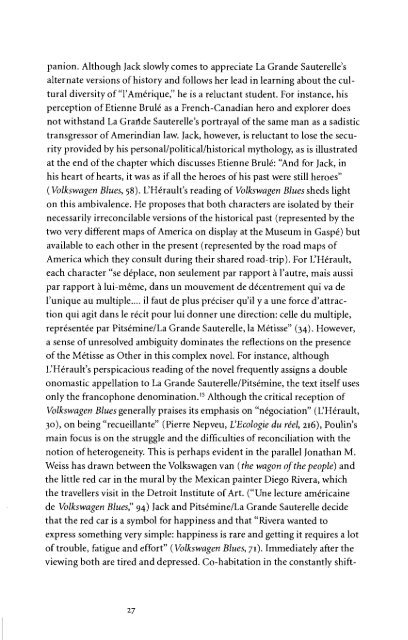The Carpathians - University of British Columbia
The Carpathians - University of British Columbia
The Carpathians - University of British Columbia
Create successful ePaper yourself
Turn your PDF publications into a flip-book with our unique Google optimized e-Paper software.
panion. Although Jack slowly comes to appreciate La Grande Sauterelle's<br />
alternate versions <strong>of</strong> history and follows her lead in learning about the cultural<br />
diversity <strong>of</strong> "l'Amérique," he is a reluctant student. For instance, his<br />
perception <strong>of</strong> Etienne Brûlé as a French-Canadian hero and explorer does<br />
not withstand La Graflde Sauterelle's portrayal <strong>of</strong> the same man as a sadistic<br />
transgressor <strong>of</strong> Amerindian law. Jack, however, is reluctant to lose the security<br />
provided by his personal/political/historical mythology, as is illustrated<br />
at the end <strong>of</strong> the chapter which discusses Etienne Brûlé: "And for Jack, in<br />
his heart <strong>of</strong> hearts, it was as if all the heroes <strong>of</strong> his past were still heroes"<br />
(Volkswagen Blues, 58). L'Hérault's reading <strong>of</strong> Volkswagen Blues sheds light<br />
on this ambivalence. He proposes that both characters are isolated by their<br />
necessarily irreconcilable versions <strong>of</strong> the historical past (represented by the<br />
two very different maps <strong>of</strong> America on display at the Museum in Gaspé) but<br />
available to each other in the present (represented by the road maps <strong>of</strong><br />
America which they consult during their shared road-trip). For L'Hérault,<br />
each character "se déplace, non seulement par rapport à l'autre, mais aussi<br />
par rapport à lui-même, dans un mouvement de décentrement qui va de<br />
l'unique au multiple.... il faut de plus préciser qu'il y a une force d'attraction<br />
qui agit dans le récit pour lui donner une direction: celle du multiple,<br />
représentée par Pitsémine/La Grande Sauterelle, la Métisse" (34). However,<br />
a sense <strong>of</strong> unresolved ambiguity dominates the reflections on the presence<br />
<strong>of</strong> the Métisse as Other in this complex novel. For instance, although<br />
L'Hérault's perspicacious reading <strong>of</strong> the novel frequently assigns a double<br />
onomastic appellation to La Grande Sauterelle/Pitsémine, the text itself uses<br />
only the francophone denomination. 15 Although the critical reception <strong>of</strong><br />
Volkswagen Blues generally praises its emphasis on "négociation" (L'Hérault,<br />
30), on being "recueillante" (Pierre Nepveu, L'Ecologie du réel, 216), Poulin's<br />
main focus is on the struggle and the difficulties <strong>of</strong> reconciliation with the<br />
notion <strong>of</strong> heterogeneity. This is perhaps evident in the parallel Jonathan M.<br />
Weiss has drawn between the Volkswagen van [the wagon <strong>of</strong> the people) and<br />
the little red car in the mural by the Mexican painter Diego Rivera, which<br />
the travellers visit in the Detroit Institute <strong>of</strong> Art. ("Une lecture américaine<br />
de Volkswagen Blues? 94) Jack and Pitsémine/La Grande Sauterelle decide<br />
that the red car is a symbol for happiness and that "Rivera wanted to<br />
express something very simple: happiness is rare and getting it requires a lot<br />
<strong>of</strong> trouble, fatigue and effort" [Volkswagen Blues, 71). Immediately after the<br />
viewing both are tired and depressed. Co-habitation in the constantly shift-

















